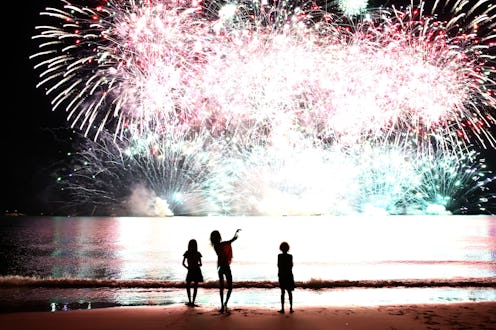Life
This Town Uses Silent Fireworks & The Reason Why Will Make You Want To Switch, Too

As anyone with a pet or two can tell you, most animals don’t like fireworks — but a town in Italy has a solution to the problem: Located in the Parma province, the town of Collecchio uses silent fireworks instead of the ones that make big, loud bangs in an effort to treat their furry, feathered, and scaled friends a little bitter. According to Excite Travel, local legislation in Collecchio requires citizens to keep their fireworks displays limited to those of the so-called “silent” or “quiet” variety “as a way of respecting the animals [of the town] and reducing the stress caused to them.” And, honestly, we could all stand to take a leaf from their book.
The law isn’t new; as the New York Times pointed out in 2016, it was passed several years ago in 2015. What's more, the use of silent and quiet fireworks has been on the rise all over Europe in recent years. But whether they’re a legal requirement or not, these kinds of fireworks are an excellent alternative to more traditional displays; while it’s true that they might lack the auditory excitement many people expect from a fireworks show, they still feature all the beautiful bursts of color lighting up the night sky that a good display has. They are, as Mental Floss put it a few years ago, “a kinder, gentler way to celebrate.”
Aerial fireworks consist of four components, according to How Stuff Works: There’s a cylindrical container made of pasted paper and string to hold everything; the “stars,” which are little pellets packed with specific chemical compounds which, when burned, create the colors you see in a fireworks display; the bursting charge, which is what’s responsible for making the firework explode; and the fuse, which “provides a time delay so the shell explodes at the right altitude.” The latter three elements are combined with black powder in the container tube and then launched with a mortar.
However, according to the New York Times, “the most explosive fireworks… have only a hint of color” due to the initial burst being “too powerful”; an overly powerful burst causes the stars to shatter. The bang may be big, but Dr. John A. Conkling, professor emeritus of chemistry at Maryland’s Washington Collage, told the Times that with these kinds of fireworks, “you really lose the whole color effect.”
Silent or quiet fireworks forego the loud noises inherent in explosively powerful fireworks to focus on the colors that can be created using stars packed with metal salts: According to EarthSky, strontium carbonate creates red fireworks; calcium chloride makes orange ones; sodium nitrate makes yellow ones; barium chloride creates green ones; copper chloride yields blue ones; and a mix of strontium and copper creates purple ones. They’re beautiful — and indeed, as the New York Times points out, many quiet fireworks are already utilized in traditional fireworks displays as a way to add visual interest to louder, less colorful fireworks.
Here’s why all this matters: Loud noises stress a lot of animals out — and fireworks can be one of the worst triggers.
Dogs are particularly prone to noise phobia; in addition to fireworks, it can be triggered by thunder or any number of other loud stimuli, according to the American Kennel Club’s Canine Health Foundation. Dogs who might be suffering from noise phobia might hide, urinate or defecate, pant, drool, pace, shake, bark, chew, try to run away, or engage in some form of behavior that might injure or even kill them (trying to run through a glass window to escape, for example). It’s no joke — and although there are things you can do to help calm your dog in situations where they might be triggered, like putting a ThunderShirt on them, one of the best things you can do is to avoid putting them in those situations whenever possible.
Nor are dogs the only animals whom fireworks can negatively affect. As Mental Floss notes, “Studies have shown that the noise created by fireworks displays create major disruptions to wildlife and livestock. Birds take flight when they should be sleeping, and some become disoriented in the post-explosion haze. Animals like rabbits and deer become frantic and can flee onto roadways or get lost.” Heck, in 2011, thousands of red-winged blackbirds literally fell out of the sky on New Year’s Eve in Bebe, Ark.; officials believe they were distressed by the fireworks the town had set off and had flown into chimneys, trees, and other obstacles as they tried frantically to escape.
And, of course, humans can also benefit from quiet fireworks: They’re often better for small children who are easily frightened, for people who have PTSD which is triggered by loud noises, for those with sensitive hearing, and more. As some wedding and event venues have also discovered — like, for example, Kilver Court in the UK — they can keep both partygoers and local residents happy by swapping out traditional fireworks for quiet ones: They offer all the bright and colorful displays without creating tons of noise late at night in otherwise quiet and residential areas.
It is, however, worth noting that “silent” and “quiet” fireworks aren’t actually completely silent; they are, after all, still explosives. As Paul Singh of Epic Fireworks in the UK told the New York Times, they are “nowhere near the 120 decibel cap placed on consumer fireworks in Britain” — but they’re still going to make noise, so adjust your expectations accordingly. If you don’t, you’ll be as disappointed as several parents in Birmingham, UK who took their kids to see a quiet fireworks display at the Birmingham Botanical Gardens on Bonfire Night in 2015 and complained afterwards that the display was too loud.
You win some, you lose some.